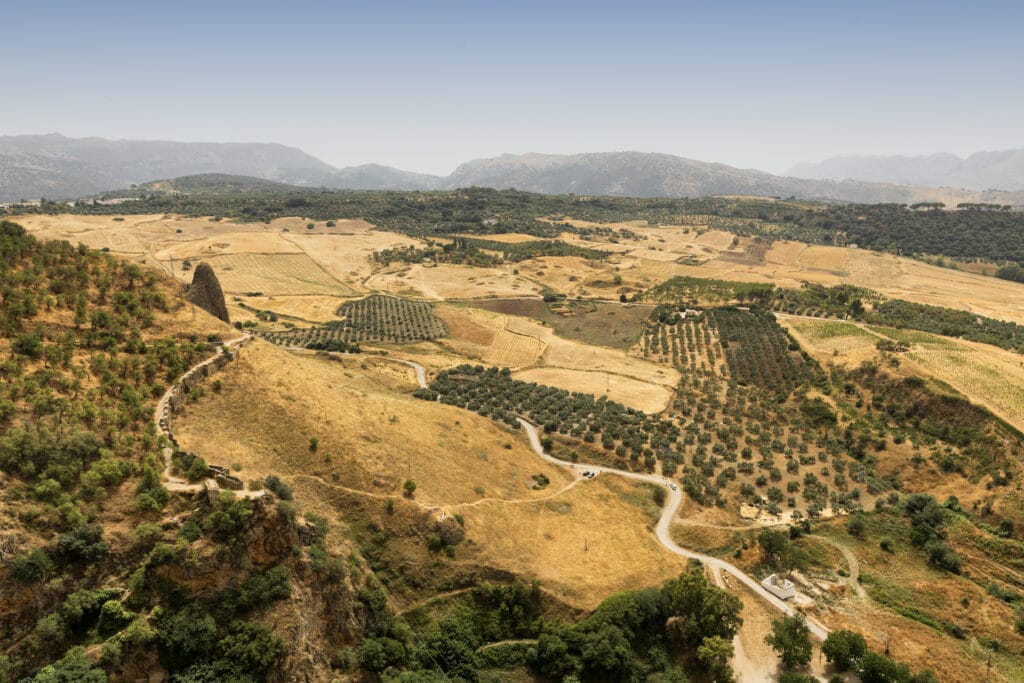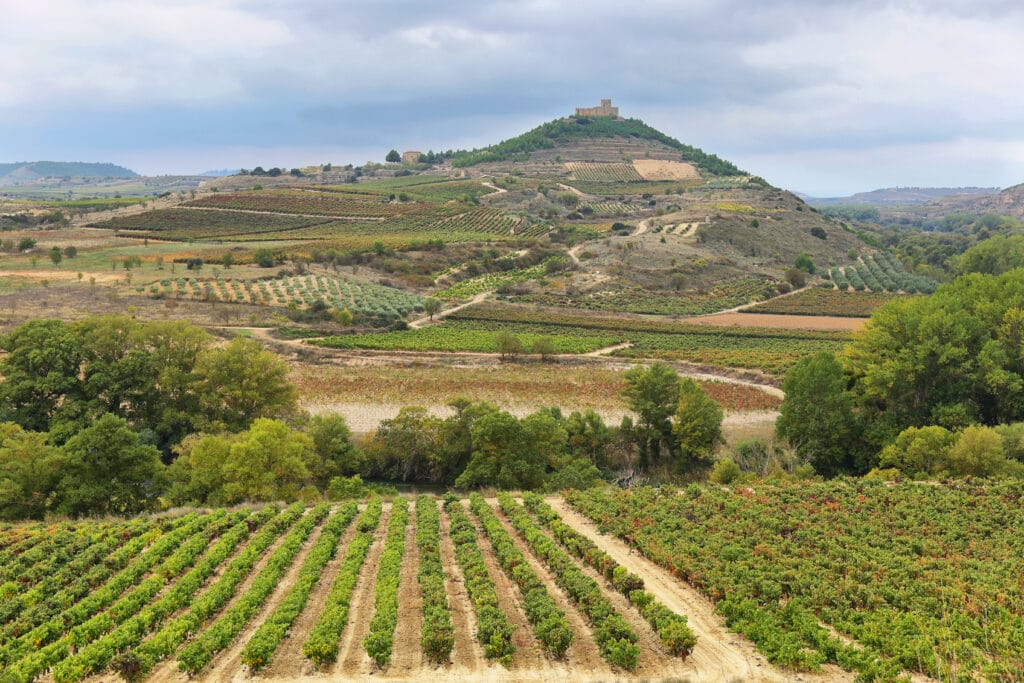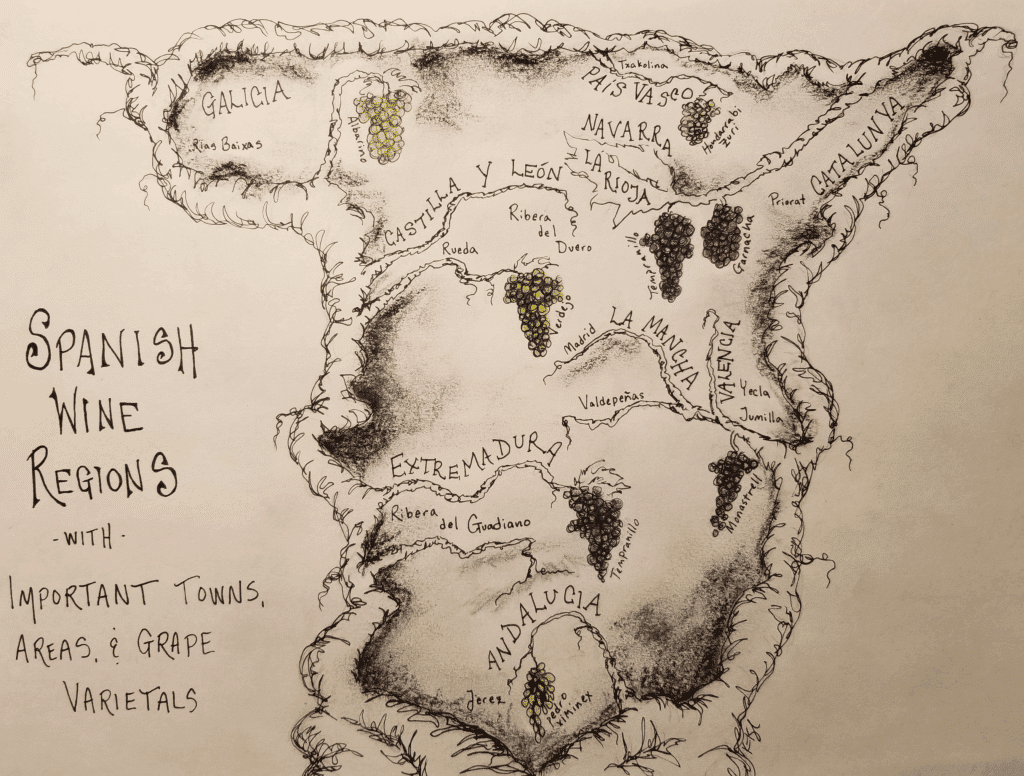Table of Contents

It is no secret that Spain has a lush terroir, bringing us the world’s most exciting cultivars and high-quality wine. As a result, Spain is now known for being one of the world’s biggest wine exporters, the world’s largest organic wine producer, and the most grape vineyards.
Spanish Wine Regions
Spain has 78 wine regions spread throughout the country – all with unique climates and terroirs – producing some truly exceptional wines. However, there are five regions that any armchair sommelier should know.
Jerez de la Frontera
Jerez produces some of the best Sherries in several different styles. The grapes grown for the Sherry production are predominantly Pedro Ximenez, Moscatel de Alejandria, and Palomino Fino.
The remarkable Sherry produced by this region is due to the uniqueness of the elements. The soil is either clay-like and chalky or extremely sandy. The ocean breeze that moves across this region helps aid the acidity in the grapes, and the never-ending sunlight concentrates the juice within the grapes enough to create the sweetness needed to produce the Sherry.
The perfect combination of all these elements is why this region can produce the Sherry it does today, an essential Spanish wine.

Rias Baixas
Regarding world-renowned white wines, Rias Baixas is at the top of the list. Located on Spain’s coast, this area’s grapes develop a robust mineral flavor – popular among Sauvignon Blanc lovers. In addition, the climate in this area is exceptional – with winters not dropping below freezing and summers just being hot enough to ensure proper development of the grapes. Although this area does experience devastating winds and storms, the vines that survive produce exceptional quality.

Pais Vasco
Right up on the border of France lies the Atlantic region of Pais Vasco. The region’s unique characteristics and quality grapes have resulted in the region gaining quite a reputation. Although not famous for its wine as much as its cuisine, the region has proven to develop some refreshing wines. Some varietals include Hondarrabi Zuri, Hondarrabi Beltza, and Petit Manseng.

Ribera Del Duero
This region has a truly unique profile. Based along the Duero River, its soil comprises a combination of soils—including limestone, chalk, and clay—which gives it a real Ribera Del Duero touch. In addition, this region prides itself on growing predominantly quality red grapes, with the wines being highly complex and able to age well. Ribera is most applauded for its high-quality, bold Tempranillo, with most of its vines being more than 25 years old.
Costers del Segre
Costers del Segre’s vines can endure a lot, incorporating both trellis and low bush in their production. This region experiences extreme heat and extreme cold, as well as hailstorms and periods of drought throughout the year. These harsh conditions do, however, allow the grapes to become highly concentrated and flavorful. These varietals include Sauvignon Blanc, Riesling, Parellada, Merlot, and Syrah.

Yecla/Jumilla
The evidence shows that wine grapes have been grown here for over 2000 years – and have continued to do it successfully. Yecla is Spain’s smallest wine region, but they grow many cultivars here. The success of the vines in this harsh, dry climate is thanks to the limestone soil that holds water throughout the dry season. In this region, you can expect to find predominantly Mourvedre and Grenache.
Toro
This Spanish wine region predominantly grows Tempranillo over 95% of the region’s plantations. The climate in the region allows the grapes from this region to generally develop high alcohol levels that also make the wines grippy and acidic. It wasn’t a well-known region, but it has come to build itself an excellent reputation with time.

Priorat
Priorat is well known for its rich, free-draining soil and production of top–quality grapes. Annually, this region gets up to 3000 hours of sunlight and less than 15 inches of rain. Most vineyards are planted on extremely steep slopes with incredibly rocky soil. Priorat is one of the most extreme wine regions in the world.
However, this area does receive shockingly low yields, but the quality of the grapes produced compensates for the lack of yield. This region produces the country’s top Carignan and Grenache, Cabernet Sauvignon, Merlot, and Syrah, almost always as blends.
Rioja
Moving toward the central part of the country, some of the main varietals in this area are Maturana, Carignan, Grenache, and Macabeo. This region is significant because the Cantabrian Mountains shelter the vineyards from cold temperatures and strong winds.
This region’s soil is also rich in limestone, so the grapes have good drainage and are slightly sweeter. Wines from this area are famous for having firm tannins, exceptional fruitiness, and excellent aging potential. They are, however, mainly used in blending as the grapes from this region often have too much acidity and almost no aroma.

Spanish Wine Grapes
Spain grows over 400 different grape varietals, but only 20 of them are commonly used to produce wine. There is an entire festival to celebrate the grape harvest in Spain –which has different parades, competitions, and tastings throughout.

Red Varietals
Bobal. This is a full-bodied red wine unique to Spain. An up-and-coming wine, Bobal also makes sparkling wine and Rosé.
Monastrell. A great full-bodied wine with immense meatiness and dominant herbaceous aromas. An ancient grape that dates back to the Phoenicians.
Mencia. Grown in Northwest Spain, this fruity, medium-bodied red is a great varietal for keeping long-term.
Tempranillo. Spanish Tempranillo wine is a full-bodied red that is famous for its notable aromatic or flavor characteristics. It is probably the most well-known grape in Spain, and the ideal match for rich, meaty meals.
Grenache. A wine of dark fruits, lush body, and sweet spice notes; Grenache is often lighter in color and rarely aged in oak. One of the most popular and prolific grapes in Spain.
Prieto Picudo. This red wine grape is often used for blending or Rosé. Prieto Picudo is similar to Tempranillo and has prominent flavors of berries and a noticeable minerality.
Listan Negro. This wine hails from the Canary Islands. Listan Negro has distinct flavors of banana and spices because of its soft tannins and lighter body. In the Americas, this is known as the Mission grape.
White Varietals
Verdejo. A tremendous light wine to pair with food, this varietal often has lemon, grapefruit, and peach flavors.
Albariño. Known for its bright acidity and fresh citrus flavors, Albariño is a popular white varietal from the Rias Baixas region. It often features notes of peach, apricot, and melon, making it an excellent match for seafood and light dishes.
Macabeo. Also known as Viura, Macabeo is widely grown in Rioja and Catalonia. This versatile grape produces crisp, floral wines with flavors of green apple, pear, and citrus, often used in Cava production.
Godello. Grown primarily in Galicia, Godello is celebrated for its balanced acidity and complex flavor profile. Expect aromas of stone fruits, herbs, and minerals, with a rich, creamy texture on the palate.
Xarel-lo. One of the three main grapes used in Cava, Xarel-lo is known for its robust acidity and ability to age well. Wines made from this varietal often exhibit flavors of apple, pear, and a hint of nuttiness, contributing to the complexity of Spanish sparkling wines.
It is no wonder that Spain produces such fantastic wines, considering their distinctive terroir and exciting varietals.
Spanish Wine Map

Our personal favorite wine map was created by winemaker Karin Kozlowski.
Spanish Wine Terms
Vino de la Tierra (VT). A wine made with more relaxed viticultural and vinicultural standards than one of the DO/DOCa categories because it is from a particular region with identifiable characteristics.
Denominación de Origen (DO). A legally defined grape/wine production area with specific rules for its member producers.
Denominación de Origen Calificada (DOCa). Only DOs that meet specific, strict requirements can be classified as DOCa. The DO must have been in existence for at least ten years and bottles must cost twice the national average cost to qualify for this classification.
Vino de Pago. A wine category of highly regarded, single-estate wines from terroir-driven vineyards that must be grown, vinified, and bottled on the estate itself.
VOS. This is an acronym for “Vinum Optimum Signatum” or “Very Old Sherry.” This refers to sherry wines that are at least 20 years old.
VORS. A term that signifies sherry wines with an average minimum age of 30 years, or “Vinum Optimum Rarum Signatum.”
Solera. Soleras are fractional blending and aging systems where older wine is withdrawn from barrels (known as a “butt”) and replaced with younger vintages.
Frequently Asked Questions
What is a popular Spanish wine?
The most popular Spanish wine is Rioja Crianza. This wine offers great value for money.
What is Spanish wine called?
In Spain, wine is called vino.
What is Spain’s best wine?
There are thousands of great wines from Spain, so picking out the best bottle is difficult. That said, we believe the best wine to be Dominio de Pingus “Pingus” from Ribera del Duero. It is also the most expensive Spanish wine.
What kind of wine is a Tempranillo?
Tempranillo is a high-acid red wine with complex tannins and a medium body. Its varietal fingerprint is anise and raw leather.
What is the most popular wine in Spain?
Wine-Searcher says the most popular wine in Spain is Vega Sicilia’s “Unico Gran Reserva” from Ribera del Duero.
